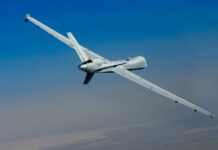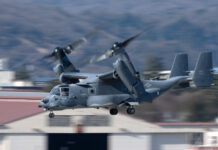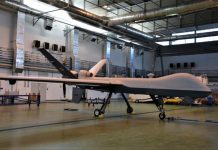General Atomics Aeronautical Systems Inc (GA-ASI) and the US Air Force Special Operations Command (AFSOC) have worked collaboratively to execute several capability demonstrations as part of AFSOC’s Adaptive Airborne Enterprise (A2E) concept development, GA-ASI announced on 5 February 2024.
A2E is a product of AFSOC shifting its priority away from counter-terrorism/insurgency operations to also being capable of countering near-peer and peer adversaries in contested or denied environments, meaning that platforms like the MQ-9A Reaper remotely piloted air system (RPAS) are used for missions beyond just intelligence, surveillance and reconnaissance (ISR) and strike operations.
The A2E demonstrations took place in December 2023 in New Mexico: at Cannon Air Force Base and Melrose Air Force Range. The first one featured the simultaneous control of three MQ-9As by a single crew using the government-owned AFSOC RPA Control Suite (ARCS). This adds additional capability to the ground control station (GCS) by allowing a standard crew to control multiple unmanned aerial vehicles (UAVs). The second demonstrated showed that an MQ-9A can launch an ALTIUS-600 small UAV from a launch pod (ALTIUS stands for air-launched, tube-integrated, unmanned system and encompasses a family of UAVs developed by US UAV specialist Area-I).
“We have established a great partnership with AFSOC,” David R Alexander, president of GA-ASI, was quoted as saying in a company press release. “We know our RPA will be a key building block for AFSOC to achieve its A2E vision.”
AFSOC is acquiring three MQ-9Bs from GA-ASI for rapid prototyping and will forego a traditional GCS to control them. Rather, AFSOC intends to control both the MQ-9A and MQ-9B aircraft, as well as a family of small UAVs, from the ARCS. The December 2023 event demonstrated the viability of ARCS to control the MQ-9A platform, which will lay the foundation for future work to integrate the MQ-9Bs into ARCS. AFSOC launched the three MQ-9As using GA-ASI’s Portable Aircraft Control Stations (PACS) and GCSs. Once airborne, however, control for the three MQ-9As was handed from the three GCSs to a single ARCS workstation. Control of all three aircraft was then handed back from ARCS to each GCS and the three aircraft performed landings under satellite communications control via GA-ASI’s Automatic Take-off and Landing Capability (ATLC).
The event also demonstrated the viability to operate MQ-9s as surrogates for small UAVs, all of which will be controlled by ARCS.

The A2E concept envisions AFSOC projecting air power from beyond the horizon using a family of large unmanned aircraft along with small, expendable UAVs, from permissive to denied environments.
“The MQ-9B is the ideal platform for inserting air-launched effects into potentially hostile environments,” GA-ASI said in its press release. “The MQ-9B’s combination of range, endurance, reduced manpower footprint, and overall flexibility will key to AFSOC’s future family of advanced [unmanned aerial] systems.”















